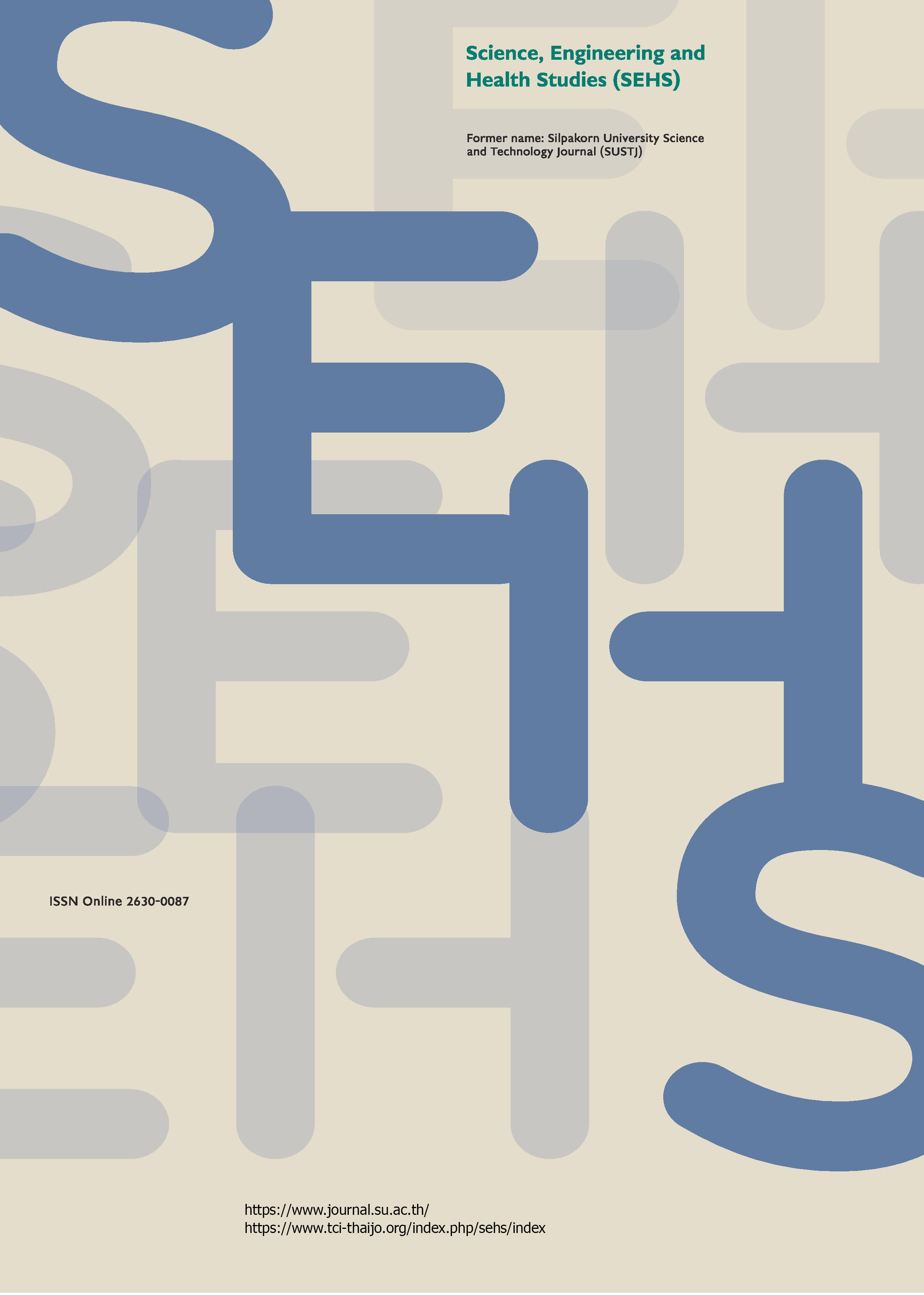Effect of wash cycle on physical and chemical properties of rehydrated jellyfish by-products and jellyfish protein powder
Main Article Content
Abstract
Production of salted jellyfish for export generates many minced or broken pieces as by-products, which have been sold as feed at a low price. From an economic perspective, changing the jellyfish by-products to a valued powder is needed. The washing of the salted by-products is a preparative step that has been changed from general washing to a mechanical washing machine for cost benefits. Little research on reducing salts and changes in mechanical washed jellyfish has been reported to date. Thus, this research aimed to determine the wash cycle’s effect using the washing machine on loss and washed jellyfish by-products qualities. Results showed that the reduction of the salt content was from 14.28±0.03% to 3.08±0.11%, 1.10±0.11%, and 0.85±0.07%, and the washing losses were 27.39±0.94%, 38.92±0.93%, and 42.18±0.85% after performing the first, second, and third wash cycle, respectively. Results also showed that the increased wash cycle decreased the volatile compounds of hexanal, heptanal, octanal, nonanal, and 2,2-dimethyl-propanoic acid indicated as unsatisfied fishy grassy, fatty, green, ether, and pineapple odors, respectively. The quality of jellyfish powder selected from the second wash cycle had the protein, fat, moisture, and ash content of 76.41±0.14%, 1.35±0.00%, 7.69±0.00%, and 15.76±0.13% with brown color and minimal fishy odor.
Downloads
Article Details
References
AOAC. (2000). Official Methods of Analysis of AOAC International, 17th, Maryland, USA: AOAC International.
Brotz, L., Schiariti, A., Lopez-Martı'nez, J., Alvarez-Tello, J., Hsieh, Y. H. P., Jones, R. P., Quin˜ones, J., Dong, Z., Morandini, A. C., Preciado, M., Laaz, E., and Mianzan, H. (2017). Jellyfish fisheries in the Americas: origin, state of the art, and perspectives on new fishing grounds. Reviews in Fish Biology and Fisheries, 27(1), 1-29.
Charoenchokpanich, W., Rungsardthong, V., Vatanyoopaisarn, S., Thumthanaruk, B., and Tamaki, Y. (2020). Salt reduction in salted jellyfish (Lobonema smithii) using a mechanical washing machine. Science, Engineering and Health Studies, 14(3), 184-192.
Giri, A., Osako, K., and Ohshima, T. (2010). Identification and characterisation of headspace volatiles of fish miso, a Japanese fish meat based fermented paste, with special emphasis on effect of fish species and meat washing. Food Chemistry, 120(2), 621-631.
Hsieh, Y-H. P., and Rudloe, J. (1994). Potential of utilizing jellyfish as food in Western countries. Trends in Food Science & Technology, 5(7), 225-229.
Hsieh, Y-H. P., Leong, F-M., and Rudloe, J. (2001). Jellyfish as food. Hydrobiologia, 451, 11-17.
Hu, J., Zhou, F., Lin, Y., Zhou, A., Tan, B. K., Zeng, S., Hamzah, S. S., and Lin, S. (2019). The effects of photodynamically activated curcumin on the preservation of low alum treated ready-to-eat jellyfish. LWT-Food Science and Technology, 115, 1-6.
Huang, Y. W. (1988). Cannonball jellyfish (Stomolophus meleagris) as a food resource. Journal of Food Science, 53(2), 341-343.
Jiang, Z., Wang, L., Che, H., and Tian, B. (2014). Effects of temperature and pH on angiotensin-I-converting enzyme inhibitory activity and physicochemical properties of bovine casein peptide in aqueous Maillard reaction system. LWT-Food Science and Technology, 59(1), 35-42.
Kchaou, H., Benbettaied, N., Jridi, M., Nasri, M., and Debeaufort, F. (2019). Influence of Maillard reaction and temperature on functional, structure and bioactive properties of fish gelatin films. Food Hydrocolloids, 97, 1-14.
Kromfang, I., Chikhunthod, U., Karpilanondh, P., and Thumthanaruk, B. (2015). Identification of volatile compounds in jellyfish protein hydrolysate. International Journal of Applied Science and Technology, 8(2), 153-161.
Klaiwong, T., Hutanguru, P., Rutatip, S., Wongsa-ngasri, P., and Thumthanaruk, B. (2014). Comparative properties of pepsin hydrolyzed jellyfish protein from salted jellyfish. Journal of Agricultural Science and Technology, 4, 555-564.
Kuraya, E., Touyama, A., and Watanabe, K. (2018). Chemical investigation of the volatile compounds of Alpinia zerumbet leaves using DH-TD-GC/MS. Facta Universitatis, Series Physics, Chemistry and Technology. 16(1), 76.
Lan, X., Liu, P., Xia, S., Jia, C., Mukunzi, D., Zhang, X., Xia, W., Tian, H., and Xiao, Z. (2010). Temperature effect on the non-volatile compounds of Maillard reaction products derived from xylose–soybean peptide system: Further insights into thermal degradation and cross-linking. Food Chemistry, 120(4), 967-972.
Omori, M., and Nakano, E. (2001). Jellyfish fisheries in Southeast Asia. Hydrobiologia, 451(1-3), 19-26.
Pedersen, M. T., Brewer, J. R., Duelund, L., and Hansen, P. L. (2017). On the gastrophysics of jellyfish preparation. International Journal of Gastronomy and Food Science, 9, 34-38.
Pedersen, M. T., and Vilgis, T. A. (2019). Soft matter physics meets the culinary arts: from polymers to jellyfish. International Journal of Gastronomy and Food Science, 16, 1-9.
Rodsuwan, U., Thumthanaruk, B., Kerdchoechuen, O., and Laohakunjit, N. (2016). Functional properties of type A gelatin from jellyfish (Lobonema smithii). International Food Research Journal, 23(2), 507-514.
Silaprueng, S., Thumthanaruk, B., and Wongsa-ngasri, P. (2015). Comparative functional properties of jellyfish (Lobonema smithii) protein hydrolysate as influenced by bromelain and hydrochloric acid. Journal of Food Science and Agricultural Technology, 1(1), 171-176.
Tamanna, N., and Mahmood, N. (2015). Food processing and Maillard reaction products: effect on human health and nutrition. International Journal of Food Science, 2015, 1-6.
Thumthanaruk, B., and Lueyot, A. (2014). Functional properties of jellyfish (Lobonema smithii) protein hydrolysate. The Journal of Applied Science, 13(2), 33-42. (in Thai)
Wongsa-ngasri, P., Virulhakul, P., and Thumthanaruk, B. (2008). Study of salted jellyfish production in commercial. In Proceeding of the Annual Conference on Fisheries, pp. 284-297. Bangkok, Thailand. (in Thai)
Zhu, W., Luan, H., Bu, Y., Li, X., Li, J., and Ji, G. (2019). Flavor characteristics of shrimp sauces with different fermentation and storage time. LWT-Food Science and Technology, 110, 142-151.


